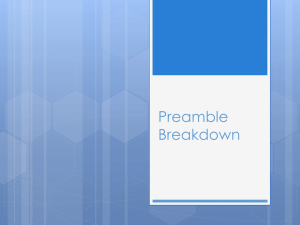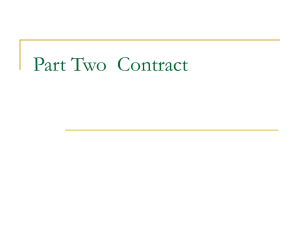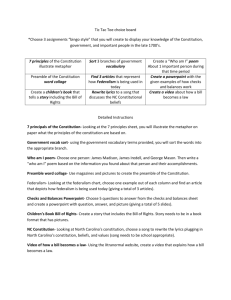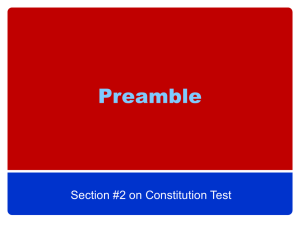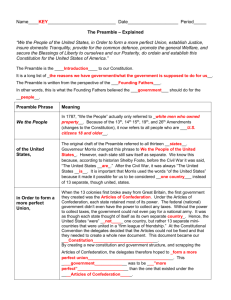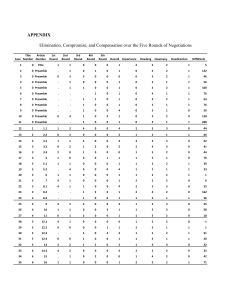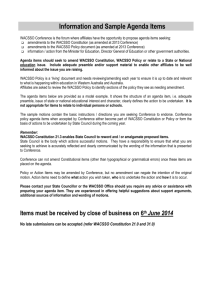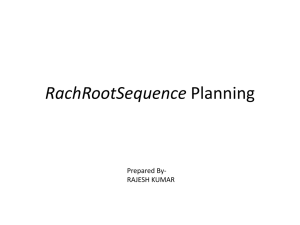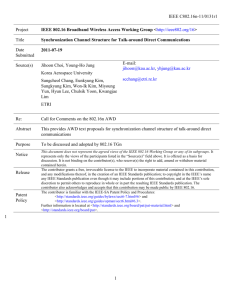Grade: 3 Unit: 5 Title: The People and the Preamble Dates of
advertisement
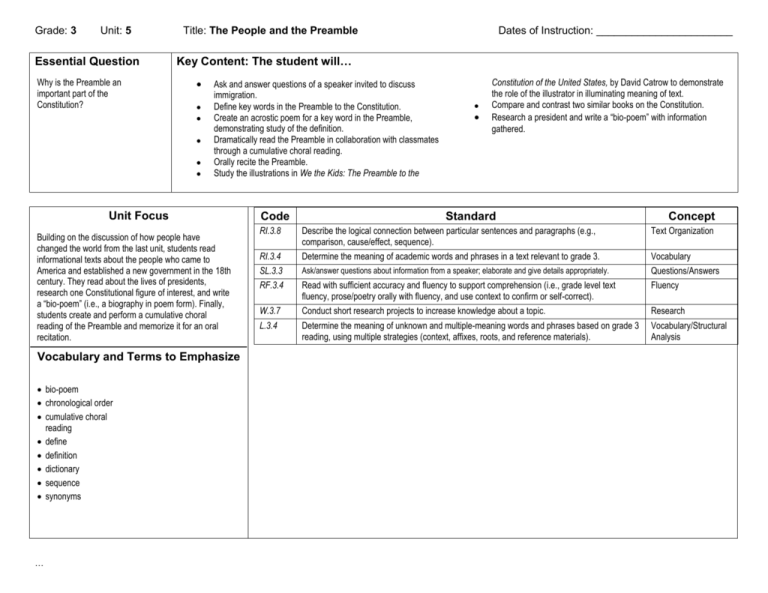
Grade: 3 Unit: 5 Essential Question Why is the Preamble an important part of the Constitution? Title: The People and the Preamble Key Content: The student will… Ask and answer questions of a speaker invited to discuss immigration. Define key words in the Preamble to the Constitution. Create an acrostic poem for a key word in the Preamble, demonstrating study of the definition. Dramatically read the Preamble in collaboration with classmates through a cumulative choral reading. Orally recite the Preamble. Study the illustrations in We the Kids: The Preamble to the Unit Focus Building on the discussion of how people have changed the world from the last unit, students read informational texts about the people who came to America and established a new government in the 18th century. They read about the lives of presidents, research one Constitutional figure of interest, and write a “bio-poem” (i.e., a biography in poem form). Finally, students create and perform a cumulative choral reading of the Preamble and memorize it for an oral recitation. Vocabulary and Terms to Emphasize bio-poem chronological order cumulative choral reading define definition dictionary sequence synonyms … Dates of Instruction: _______________________ Code RI.3.8 Constitution of the United States, by David Catrow to demonstrate the role of the illustrator in illuminating meaning of text. Compare and contrast two similar books on the Constitution. Research a president and write a “bio-poem” with information gathered. Standard Concept Text Organization RI.3.4 Describe the logical connection between particular sentences and paragraphs (e.g., comparison, cause/effect, sequence). Determine the meaning of academic words and phrases in a text relevant to grade 3. SL.3.3 Ask/answer questions about information from a speaker; elaborate and give details appropriately. Questions/Answers RF.3.4 Read with sufficient accuracy and fluency to support comprehension (i.e., grade level text fluency, prose/poetry orally with fluency, and use context to confirm or self-correct). Conduct short research projects to increase knowledge about a topic. Fluency Determine the meaning of unknown and multiple-meaning words and phrases based on grade 3 reading, using multiple strategies (context, affixes, roots, and reference materials). Vocabulary/Structural Analysis W.3.7 L.3.4 Vocabulary Research Grade: 3 Unit: 5 Title: The People and the Preamble Dates of Instruction: _______________________ Suggested Activities/Investigations/Demos: 1. 2. 3. 4. 5. 6. CLASS DISCUSSION/LANGUAGE: Introduce the unit by writing the three key words on the board: “people,” “Preamble,” and “presidency.” While working through each word (possibly over a few days/class periods), give students a copy of a prepared semantic map and display (on an overhead projector, document camera, or SMART Board, for example). Use a dictionary as reference and begin with the word “people.” To ensure full participation, require each student to “turn and talk” about each part of the map before filling in the spaces. Maps such as these create a richer understanding of a word they already know (e.g., people) by looking at parts of speech and the word’s synonyms. LANGUAGE: Divide students into groups of three or four and give them one of the key words (“people,” “Preamble,” or “presidency”). Ask them to write the word on a poster in large bold print. Then have them use their semantic maps to create symbols, pictures, and words (synonyms) that illustrate the rich meaning of each word. Hang the posters around the room and refer to throughout the unit. CLASS DISCUSSION/LITERATURE: Discuss the book Coming to America: The Story of Immigration, by Betsy Maestro as telling the story of immigration. Tell students that America is unique because so many people have come from so many different parts of the world and backgrounds. To understand how all of these people groups came to the same place, challenge students to think about the sequence of events in America’s history. Define “chronological order” and perhaps relate it to something, such as a daily schedule or school calendar. As the book is read aloud, have students jot down important events on note cards, keeping them in “chronological order.” Ask readers to then think about why rules are needed to guide our government. DRAMATIC READING/FLUENCY: Divide the class into eight groups to perform a cumulative choral reading of the Preamble to the Constitution (see Resources). Have a group read to the first comma, the second group read to the next comma, etc. Continue adding voices/phrases until the whole class is reading the Preamble. LANGUAGE ACTIVITY/ACROSTIC POEM: Using the formatted Preamble text below, give students the following instructions: “Choose a key word (in bold) from the Preamble. Look up the meaning in the dictionary, practice using it in a sentence, and then create an acrostic poem showing what the word means. Include defining phrases, simple similes, or synonyms in the poems.” Do one as a class example and then have the students work independently or put the students with partners to complete the task. We the People of the United States, in Order to form a more perfect Union, establish Justice, insure domestic Tranquility, provide for the Common Defense, promote the general Welfare, and secure the Blessings of Liberty to ourselves and our Posterity, do ordain and establish this Constitution for the United States of America. Give the students this prompt: “Choose an individual involved in the writing of the Constitution. Research this individual using online sources, an encyclopedia, and a biography (about him). Then, write a poem about him, or “bio-poem”, based on the research performed. Use the following format to organize your poem: Line 1: First, middle, and last name Line 2: Four jobs held by the man during his life (other than presidency) Line 3: Birthplace, Child of Line 4: Enthusiast of Line 5: Educated at Line 6: Resident of Line 7: Three contributions made Line 8: Number order of president (ordinal number) Line 9:Nickname 7. FIELD TRIP (optional): Ellis Island tour (either in-person or virtual). … Strategies Semantic Map Semantic Map Discussion Grade: 3 Unit: 5 Title: The People and the Preamble Dates of Instruction: _______________________ Cross-curricular Connections Resources Religion/Values: Examine the words in the Preamble and relate them to God’s sense of liberty, justice, equality, and the promotion of love for one another. Click this link for the Constitution of the United States http://constitutionus.com/ Social Studies: Discuss how the Constitution is an important element of U.S. culture. Study the country’s symbols as they relate to the Constitution (e.g., Statue of Liberty, the bald eagle). Click for timelines http://www.internet4classrooms.com/timelines.htm Math (Content Concept: Timelines): Guiding Question: “How do events in history coincide with the lives of the presidents?” Assessing Student Understanding Have students choose two books about presidents to compare and contrast, such as Elizabeth Levy’s If You Were There When They Signed the Constitution and Shh! We’re Writing the Constitution, by Jean Fritz. Ask students to answer the following questions in their journals, “In what ways are the two books similar? How are they different?” Complete a Venn diagram comparing two books written about the same president. Write a two-page essay describing the similarities and differences between two different Constitutional figures. Have students rewrite the Preamble in their own words. Have students write a bio-poem about a person they admire. Perform the Preamble independently as an oral recitation. Teacher Notes/Reflections …

